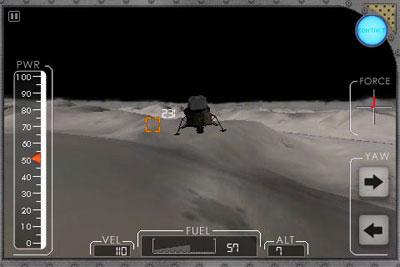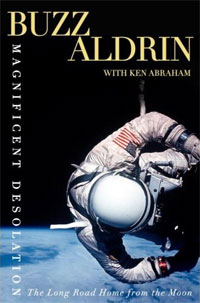Reviews: Remembering Apollo in ways old and newby Jeff Foust
|
| After the post-mission hoopla died down, Aldrin struggled to figure out what to do next—a challenge that made going to the Moon pale in comparison, in some respects, for what do you do after you’ve gone to the Moon? |
In that latter case is the new book by Buzz Aldrin, Magnificent Desolation. In the sea of books recently published about the mission, his stands out not just because it’s the only one written by one of the members of the mission, but because it deals primarily with what happened to Aldrin after that historic flight. Aldrin kicks off the book with a description of the mission itself—one that at times seems a little rushed, as if he’s in a hurry to get past that chapter in his life and on to what happened in the four decades that followed.
The general outlines of that history are well-known: after the post-mission hoopla died down, Aldrin struggled to figure out what to do next—a challenge that made going to the Moon pale in comparison, in some respects, for what do you do after you’ve gone to the Moon? This led to bouts of depression and a struggle with alcoholism, which Aldrin recounts in great detail in Magnificent Desolation. Aldrin had already discussed some of this in an earlier memoir, Return to Earth, but that book only covered his struggles in the early years after Apollo. This book makes it clear that Aldrin had to deal with challenges that persisted long after his earlier memoir was published, including a long-running but eventually successful battle against alcoholism and occasional “blue funks” that would hit him even decades later.
Separate from those personal struggles were professional challenges he faced, first in a short-lived return to the Air Force and, later, efforts in developing various technical contributions to the field, such as “cycler” spacecraft for ferrying crews between the Earth and Mars, or his Starbooster launch vehicle concepts. He also describes his efforts to promote space to the general public through projects like the Sharespace Foundation.
While Aldrin has taken a conventional approach in describing his life over the last four decades, others have pushed the limits of technology to describe that historic mission or build entertainment off of it. That concept is not new: in the 1970s and early 1980s some variant of “lunar lander” games—often written in BASIC and using ASCII character graphics—were common on computer systems, including the embryonic home computer field. The goal of that game was simple: land the spacecraft on the surface of the Moon, being careful not to land too fast or run out of fuel.
 |
“Apollo 11: The Game” takes that concept to a new level, and on a new platform: Apple’s iPhone. The rudimentary graphics of those early games have been replaced with high-resolution imagery of the Earth, Moon, and spacecraft, rendered on the iPhone’s small screen. This game does feature a lunar lander task, but as one of only several challenges players must undertake, ranging from flight tests of the Lunar Landing Training Vehicle back on Earth to a successful reentry of the command module at the end of the mission.
The game takes advantage of the ability of the iPhone to detect its orientation and movement: users tilt and rotate the phone in order to move the lander or spacecraft around, and tap controls on the screen to adjust the throttle or make other changes. In some cases the game is extraordinarily sensitive to changes in the orientation of the phone: even a little jitter can send you off-course. (You may want to lay off the caffeine before playing.) That sensitivity at times can be frustrating.
It should be made clear that “Apollo 11: The Game” is meant to be entertainment, not a documentary. For example, when going through the landing phase of the game, you have to pilot the lander through a series of waypoints that appear as blue dots on the screen. When you pass through one, though, fuel is added to your lander—a benefit that Neil and Buzz didn’t have 40 years ago. The game can be also be slow and sluggish at times: it takes a couple of minutes to go through the instructions for each new level, displayed as communications between the capcom in mission control and the Apollo 11 crew, when it easily could be displayed much faster. But if you’re willing to put up with those glitches, the game can provide some brief bits of entertainment associated with the mission.
| “I still get frustrated at times,” Aldrin writes, “because I am a visionary often stymied by a bureaucratic maze.” |
Meanwhile, “We Choose the Moon”, a web site developed by AOL in conjunction with the John F. Kennedy Presidential Library and Museum, sticks to the facts of the Apollo 11 mission, but presents them in a novel way. The site offers a “real-time” look at what was going on with Apollo 11 exactly 40 years ago: go there today and you can follow the final hours leading up to Eagle’s landing on the Sea of Tranquility and Armstrong’s historic step onto the lunar surface. The site offers the audio feeds between mission control and the crew, playing in the background, as well as photo galleries and video. The one drawback to the site is that it can be very slow to load: during one test it took several minutes after the progress bar on the screen reached 100% before the site displayed, long enough to make one wonder if the site was even working.
Towards the end of Magnificent Desolation, Aldrin summarizes why he thinks many of his ideas regarding space exploration that he has promulgated over the last few decades haven’t been adopted. “I still get frustrated at times,” he writes, “because I am a visionary often stymied by a bureaucratic maze.” That does go a long way towards explaining why many of his concepts have remained just that—concepts. There is, though, room elsewhere for novel approaches to familiar topics, at least where those bureaucratic mazes don’t exist or can be more expertly navigated. Let us hope that, as technologies advance over the next 40 years, we’re not limited to just finding new ways to tell the same story, but have new tales of space exploration to share as well.
